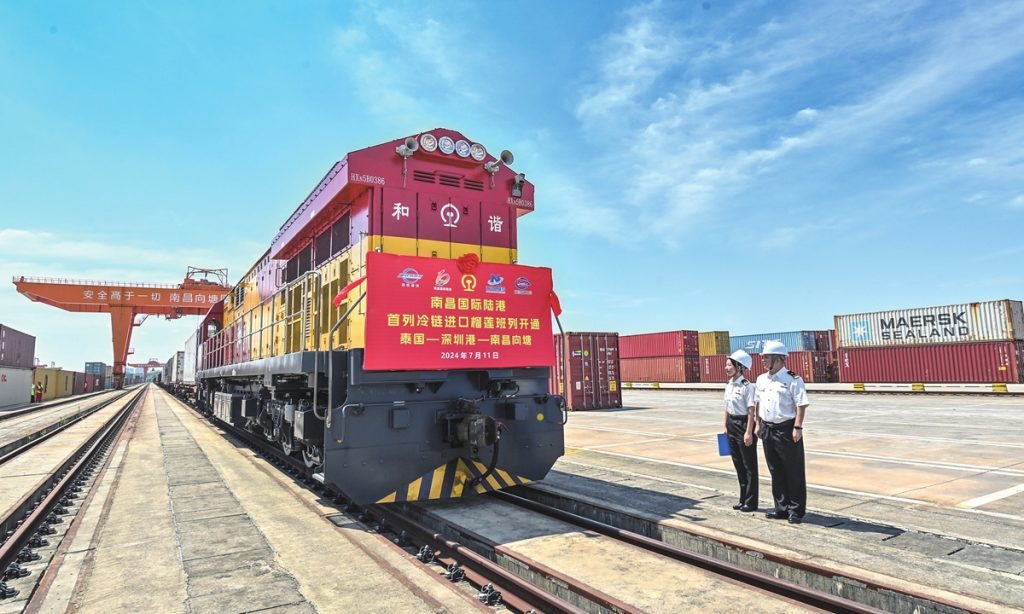China's intelligent, heavy-haul freight railway system put into operation

An intelligent over 10,000-ton heavy-haul train, led by two 12-axle locomotives, traveled from Northwest China's Shaanxi Province to North China's Hebei Province on Saturday, marking the first large-scale application of intelligent driving technology on China's heavy-haul raillines.
Two 12-axle locomotives led a 10,000-ton, 1,400-meter-long smart freight train with 108 carriages along the Shenmu-Shuozhou Railway from Shaanxi to Hebei. This signifies the large-scale implementation of intelligent driving technology for the Baoshen Railway Group's freight locomotives.
To achieve the large-scale application of the intelligent driving technology, Baoshen Railway Group in collaboration with other institutes, has overcome the challenges related to geography, routes, climate, and long gradients, setting multiple national firsts.
The technology now covers electric locomotives from 8-axle to 24-axle models, marking the first time all configurations are available. Previously, pulling a 10,000-ton train required three 8-axle locomotives and six crew members. With intelligent driving technology, only two 12-axle locomotives and two crew members are required now, or just one 24-axle locomotive with a single crew member, greatly improving efficiency and reducing pressue of the railway labor force.
More axles mean greater capacity and stronger traction, allowing fewer locomotives to haul more cargo, helping boost efficiency and reducing labor intensity, experts said.
"The implementation of intelligent driving technology has improved control precision and less labor-intensive," said a representative from a branch of Baoshen Railway Group, as quoted in a CCTV report on Saturday.
The technology first includes rain and snow specific mode which integrates weather information into the train's operating system, allowing intelligent driving control and stable operation in adverse weather conditions.
Additionally, automatic switching with BeiDou Navigation Satellite System's high-precision positioning and obstacle detection, long-distance autonomous obstacle detection and inspection on mainline sections, and panoramic monitoring with remote driving capabilities are all being applied for the first time for the heavy-haul railway system.
"China's railway development follows a dual approach for passenger and freight transport. While passenger transport technology leads globally, freight transport has lagged but is now catching up," Sun Zhang, a railway expert at Shanghai Tongji University, told the Global Times on Sunday.
"Our focus on intelligent heavy-haul transport aims to boost load capacity, improve service quality like shock absorption, and ensure safety. Enhancing freight efficiency helps us catch up with developed countries and supports the national dual carbon strategy, " said Sun.
The Shenmu-Shuozhou Railway, operated by the Baoshen Railway Group, is a national Class-I double track electrified heavy-haul railway crossing the country's plateaus. It is a crucial coal transport route from western to eastern China, travsering challenging conditions including a minimum turning radius of 400 meters and a maximum slope of 12 permil, placing a high technological burden on the rail operator.
From 2019 to 2023, the number of intelligent heavy-haul trains has reached 30, safely operating a total of 2.08 million kilometers and completing 9,508 trips, carrying 41.07 million tons of coal, according to a Xinhua report on Saturday.
The intelligent heavy-haul driving system have received SIL2 international safety certification, reflecting China's capacity in mastering core technologies in high-end manufacturing, while further enhnacing the competitiveness of China's railway transport, according to Xinhua.






